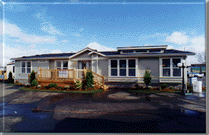We offer financing for
home & land that represents a
"single" real estate transaction that is evidenced by a recorded
mortgage or deed of trust. The foundation and type of foundation are
key aspects that allow manufactured homes to be classified as real
estate. The home should have all wheels, axles, and hitches removed
and conform to safety standards established in June 1976. The
home must be installed on a permanent and acceptable foundation.
Historically,
manufactured homes have been financed as personal property,
resulting in personal loans that often require a 10 percent down
payment, with the remainder financed over 10 to 15 years. Interest
rates are higher, resembling car and boat loans, and because the
loans aren't mortgages, the interest paid isn't tax-deductible.
These loans still are the most common. Many manufactured homes
(double wide) on land now require a minimum 5 percent down payment
or more and finance the remainder over 20 to 30 years.
If the home is immobile and if the owner of the home also owns the
underlying land, then the loan is likely to be viewed as a mortgage,
gaining vital tax benefits.
Florida Mortgage Corporation has a variety of products and programs
that vary according to down payment, the size of the home, and terms
extending out to 30 years.
We also provide manufactured home financing for your used home
purchase. If your goal is to refinance your manufactured home to
consolidate those high interest credit cards, you’re in the right
place. Unlike most lenders, we are eager to lend on manufactured
homes located in mobile home parks or manufactured home communities.
A mobile home is a factory built home on an integral chassis,
transportable in one or more sections, and which is
eight feet or more in width. All single family mobile homes
manufactured since June of 1976 must be built to standards
established by the U.S. Department of Housing and Urban Development
(HUD), and must display a label certifying compliance. One of every
three homes constructed in Florida is a mobile home.
A home is probably
the single most important purchase you will make in your lifetime.
In recent years, nearly one-third of all new single-family homes
bought have been manufactured homes.
The term "manufactured home" was adopted in 1980 by the United
States Congress to describe a type of house that is constructed in a
factory to comply with a building code developed by the Department
of Housing and Urban Development (HUD). In the past, manufactured
homes were called "mobile homes," a term that many people still use.
However, "mobile" is no longer an accurate name because fewer than
five percent of such homes are ever moved off the owner's original
site.


The exterior and
interior designs of manufactured homes resemble those of site-built
homes and offer many of the same amenities: brand name appliances;
fireplaces; walk-in closets; and spacious floor plans.
They're manufactured homes now and, with 19 million people living in
them, they're fast becoming the housing style of choice for people
who have to achieve the American Dream on a limited budget.
Today's manufactured homes bear little resemblance to yesterday's
air-slipping tin cans on wheels. With improved quality and material,
stitched together seamlessly in double-wide sections, they can be
indistinguishable from site-built, conventional homes.
Over the past few
years,
the growth rate of the manufactured housing industry has been
dramatic, and affordability has played a key role. Today's
manufactured homes offer the quality, value, and technologically
advanced features that homebuyers desire. Features include vaulted
ceilings, walk-in closets, fireplaces, state-of-the-art appliances,
spacious floorplans, customization packages, two-story models, and
exterior designs compatible with almost any neighborhood.
Manufactured homes are built in a factory-controlled environment and
are required to meet the strict HUD Code, which was established by
the Federal Government to regulate the design, construction, and
safety of these homes. The HUD Code sets standards for heating,
plumbing, air conditioning, thermal and electrical systems,
structural design, construction, transportation, energy efficiency,
and fire safety.
Manufactured housing
(including mobile homes) accounts for around 25% of annual new,
residential construction and home sales in the United States.
Millions of Americans live in manufactured homes, which represent
more than 10% of the total housing stock. In many rural areas, the
percentage is much higher. The sales prices for a new manufactured
home range from under $30,000 for a single-section home with basic
features to over $110,000 for a deluxe multisection home. Sometimes
referred to as singlewide, double wide and triple wide. Low purchase
cost, with cost savings of 20%-40% for manufactured housing over
that of site-built housing, is the major attraction of manufactured
homes. The cost of heating and cooling some older manufactured
homes, however, can be twice as much as site-built houses of
comparable size and age.
HUD Code Requirements
Unlike all other forms of factory-built housing, which must meet
state and local codes, mobile homes must conform to the U.S.
Department of Housing and Urban Development (HUD) 1976 Federal
Manufactured Home Construction and Safety Standards Acts, commonly
known as the "HUD Code." Although "manufactured housing" is a term
broadly applied to any type of factory-built housing, the 1980
amendment to the original 1976 HUD Code, defines "manufactured
homes" as mobile homes. This information brief uses the HUD
definition and focuses on mobile homes.
Those "trailer homes" of the past have gone the way of the Edsel and
the eight-track tape. Manufactured housing continues to grow in
popularity for a wide range of homebuyers. The exceptional
affordability of manufactured homes places home ownership within the
reach of many households who are priced out of the market for
site-built homes.

